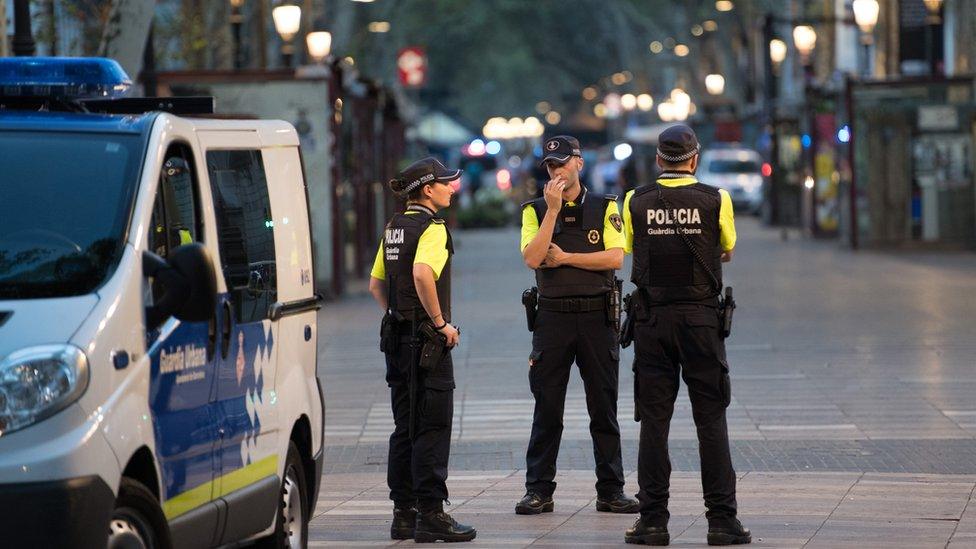Barcelona attack: Spain terror cell had 120 gas canisters
- Published
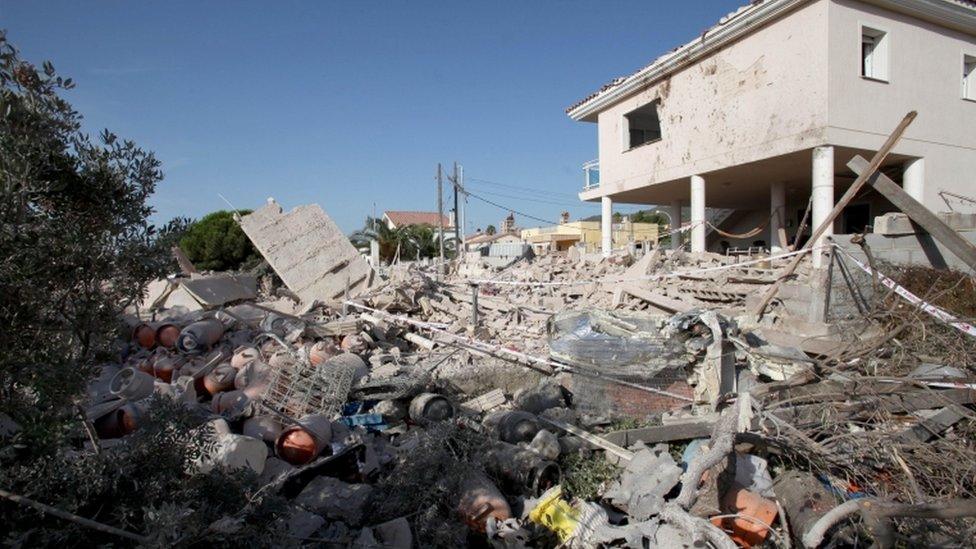
Police say the wrecked house in Alcanar is a focal point of the investigation
A 12-strong terror cell that carried out two deadly attacks in Spain had collected 120 gas canisters and was planning to use them in vehicle attacks, Spanish police say.
Canisters were found at a house, said to be used by the cell, that blew up in the town of Alcanar on Wednesday night.
Police are still hunting for the driver of the van that hit dozens of people on Barcelona's Las Ramblas, killing 13.
On Sunday, a Mass was held in Barcelona to mourn the victims.
In addition to the 13 killed on Thursday afternoon on Las Ramblas, a woman died in a second vehicle attack early on Friday in the town of Cambrils. Five suspected jihadists were shot dead by police in the second attack.
The Catalan authorities have also confirmed that a British-Australian seven-year-old, Julian Cadman, was among those killed in Barcelona.
He had been declared missing since becoming separated from his injured mother in the attack, and his family had made appeals for news of his whereabouts.
Catalan police chief Josep Lluis Trapero has given an update on the investigation.
He said the cell was still believed to consist of 12 men and had been planning attacks for more than six months. One person remained at large, four were under arrest and there were two sets of human remains to be identified, he added.
Inside the pretty town hiding terror suspects
The person at large was the driver of the van, Mr Trapero said, adding that police knew his identity but would not reveal it.
But police have confirmed they are hunting Moroccan-born Younes Abouyaaqoub, 22, who Spanish media say was the driver.
The two sets of remains to be identified may refer to victims of the house explosion at Alcanar.
Spanish media have speculated the two may be Youssef Aallaa, the brother of one of the suspected jihadists killed at Cambrils, and Abdelbaki Es Satty, an imam from the town of Ripoll, north of Barcelona, where a number of the suspects lived.
The imam apparently left the mosque in June for an extended trip to Morocco, but a flatmate told the BBC he had been seen in Ripoll as recently as last Tuesday.
"Barcelona is going to rise up again with its spirit and its openness"
"We're starting to see clearly that [the Alcanar house] was the place where they were preparing explosives for one or more attacks in the city of Barcelona," Mr Trapero said.
He added: "We are not in a position to say what caused the radicalisation of these people."
Mr Trapero said police could not rule out that the suspect still at large had crossed the French border, although he had "no specific information on this".
The father of two of those shot dead by police in Cambrils, Mohamed and Omar Hychami, told the BBC he was devastated. Hecham Igasi also accused the imam of radicalising his sons.
There was a special Mass at the Sagrada Familia church for the victims
It is now known that three vehicles were rented under the credit card of Younes Abouyaaqoub.
One was used in the Las Ramblas attack, another was found after the attack in the town of Vic and a third in Ripoll.
Mr Trapero said the cell had planned to fill all three with explosive material to carry out attacks.
Barcelona FC, in their first match since the attacks, beat Real Betis 2-0 at the Camp Nou ground on Sunday night.
Players observed a minute's silence before kick-off and wore black armbands.
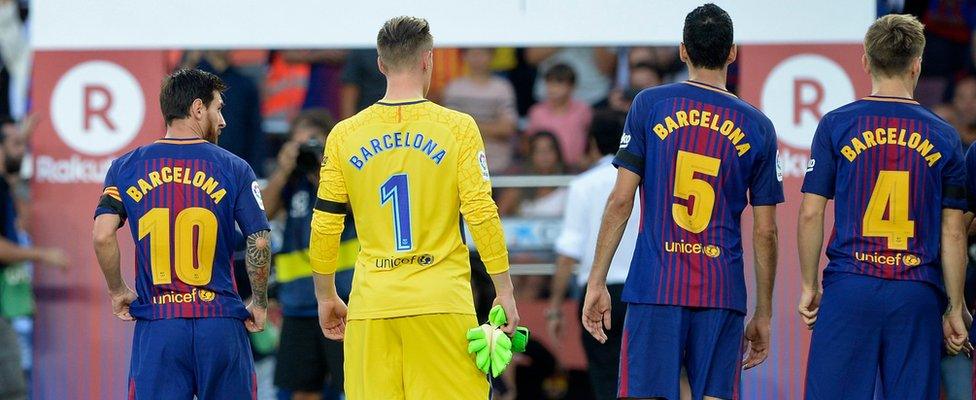
Barcelona's players lined up with shirts carrying the name of the city instead of their own names
Earlier, King Felipe and Queen Letizia attended Barcelona's Sagrada Familia cathedral to mourn those killed in the attacks
Some reports in Spanish media say the jihadist cell had intended to target the iconic, Gaudi-designed church with explosives.
Cardinal Juan José Omella, the Archbishop of Barcelona, called for peace and unity, saying: "We will overcome fear."
He read a message from Pope Francis, which said the pontiff "condemns once again the violence, which is a very grave offence against the creator, and he prays to God for help so we can continue working for peace and harmony in the world".
As the debate about possible Catalan independence continues, Cardinal Omella added: "The union makes us strong, the division corrodes us and destroys us."

Who are the suspects?
So-called Islamic State (IS) said it had carried out the Las Ramblas attack, though it is not clear whether any of the attackers were directly connected to the group or simply inspired by it.

(L-R) Moussa Oukabir, Said Aallaa, Mohamed Hychami and Younes Abouyaaqoub
Killed: Five suspected jihadists shot dead by police in Cambrils - Moussa Oukabir, 17; Said Aallaa, 18; Mohamed Hychami, 24; Omar Hychami; Houssaine Abouyaaqoub.
Arrested: Three in the town of Ripoll - Driss Oukabir, 28, the brother of Moussa, who turned himself in saying his documents had been stolen to rent vehicles; Sahal el-Karib, 34; Mohammed Aallaa, 27. Mohamed Houli Chemlal was arrested in Alcanar following the house explosion there on Wednesday.
Hunted: Younes Abouyaaqoub, now suspected to be the driver in the Las Ramblas attack. Youssef Aallaa, the brother of Said. Abdelbaki Es Satty, an imam of Ripoll. However, the latter pair may have died in the house explosion in Alcanar.

What do we know about the victims?
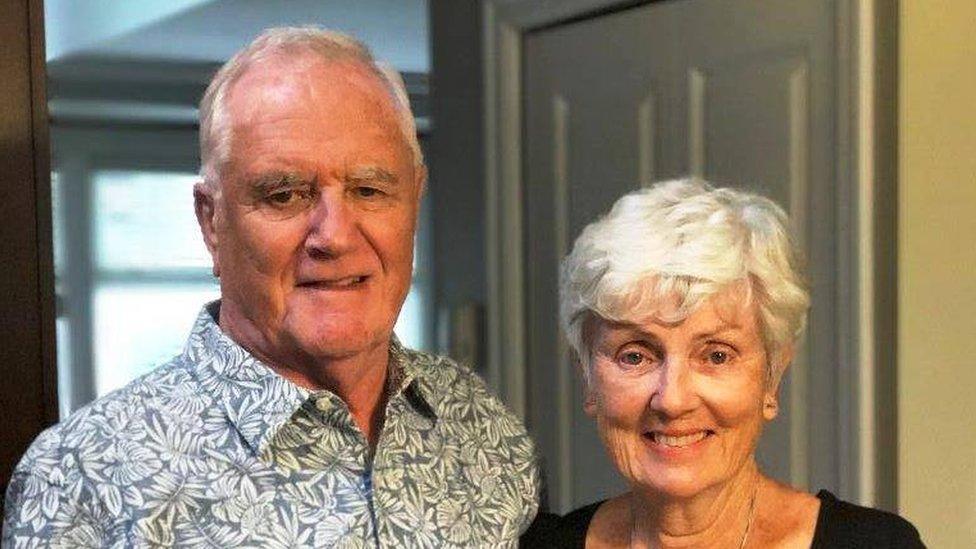
Ian Moore Wilson, pictured with his wife Valerie, is the latest named fatality from Las Ramblas
These names of the dead have so far been released:
American Jared Tucker, 43
Belgian Elke Vanbockrijck, 44
Spanish-Argentine Silvina Alejandra Pereyra, 40
Argentine Carmen Lopardo, 80
Spaniard Pepita Codina, 75
Canadian Ian Moore Wilson
Spaniard Francisco López Rodríguez, 57. His three-year-old great nephew also died
Italian Bruno Gulotta, 35
Italian Luca Russo, 25
British-Australian boy Julian Cadman, 7
Spaniard Ana María Suárez died in the Cambrils attack
Two unnamed Portuguese nationals are also confirmed dead.
What was it like to be caught up in the Barcelona attack?
The latest breakdown from Catalan emergency services on the injured reads:
Barcelona attack: 13 critical, 20 serious, 14 less serious, 2 minor
Cambrils attack: 2 serious, 2 less serious

Timeline of events

Alcanar, Wednesday evening: An explosion rips through a house in the small town 200km south of Barcelona. One person is confirmed dead, though up to three may have died. Police chief Josep Lluis Trapero said it appeared the residents at the house had been "preparing an explosive device". A Catalan government official says a cell may have intended to use gas canisters in the Las Ramblas attack.
Barcelona, Thursday 16:50 (14:50 GMT): A white Fiat van drives down Las Ramblas in central Barcelona, killing 13 people and injuring scores. The driver flees on foot.
Vic, Thursday 18:30: Police find a second van, thought to be a getaway vehicle, in the town, 80km north of Barcelona.
Sant Just Desvern, Thursday 19:30: A car is driven towards officers at a checkpoint on the outskirts of Barcelona. They open fire. A man is later found dead in the passenger seat of the car with stab wounds. The dead man is not linked to the Las Ramblas attack, officials say, but investigations are ongoing. One theory, external is that the car was stolen and the man was killed by the carjacker, who is still at large.
Cambrils, Friday 01:00: A second vehicle attack takes place in the resort south of Barcelona, killing a woman. Police kill five terrorist suspects said to be linked to the Las Ramblas attack. They include Moussa Oukabir, 17, initially thought to be the Las Ramblas attacker. Police later say another man, Younes Abouyaaqoub, is being hunted.
- Published18 August 2017
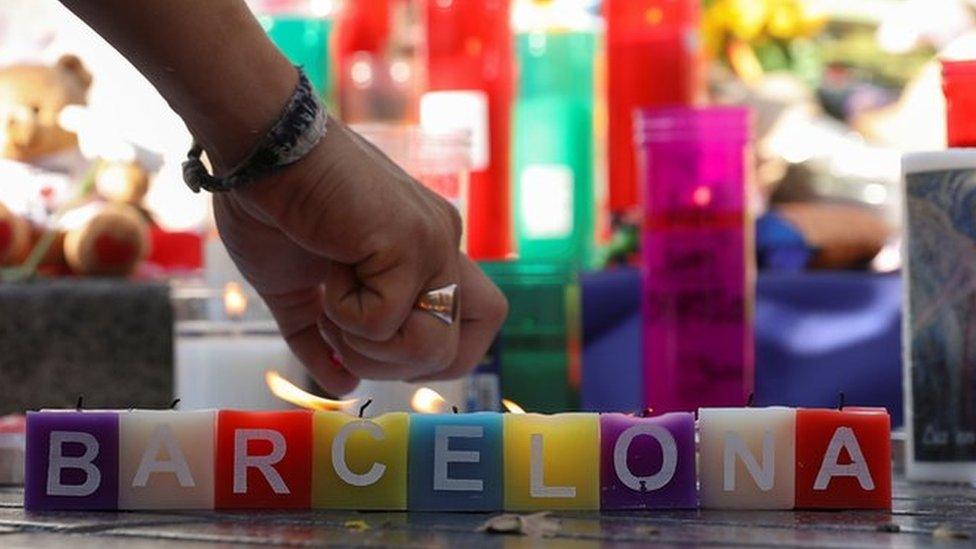
- Published27 August 2017
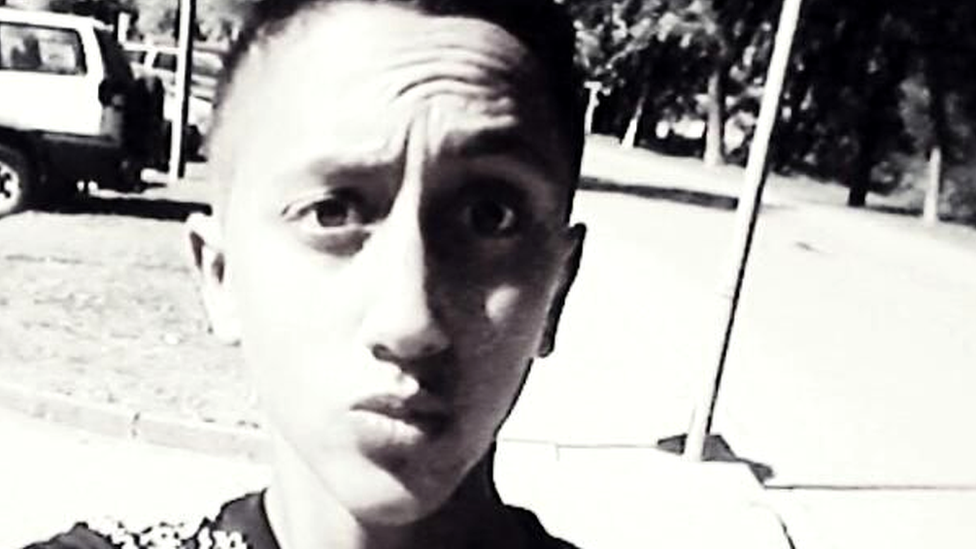
- Published18 August 2017
- Published27 August 2017
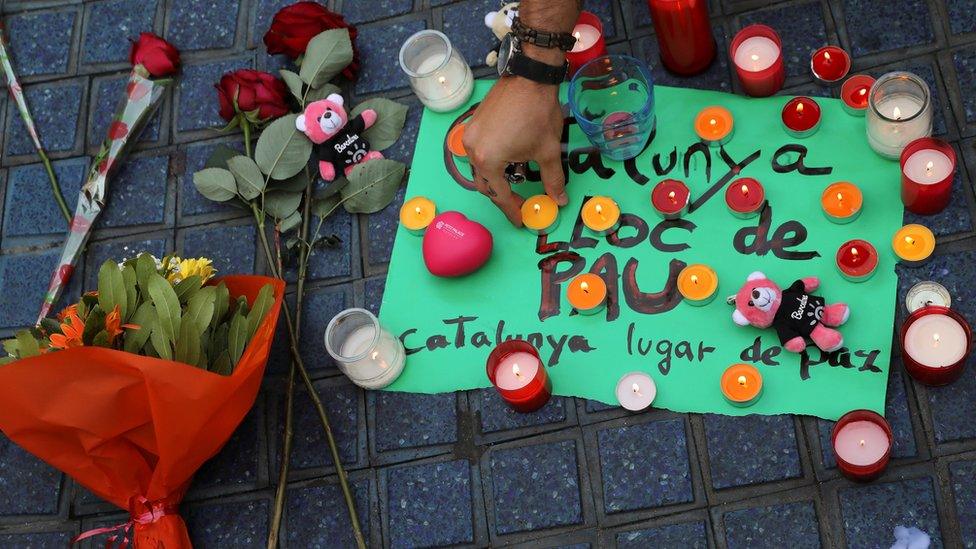
- Published18 August 2017
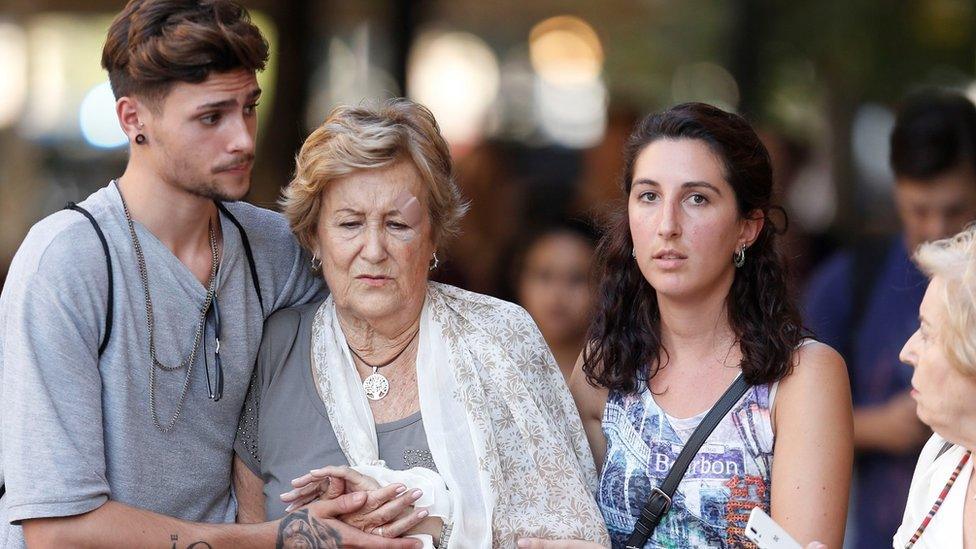
- Published18 August 2017
